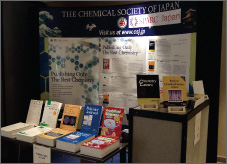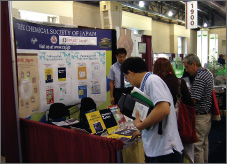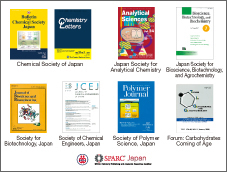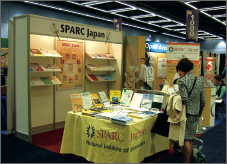 |
 |
       |
       |
 |
 |
|
Kazuko Yamashita (Society of Chemical Engineers, Japan)
Kazuhiro Hayashi (Chemical Society of Japan; SPARC Japan Steering Committee)
● Introduction
Over the last decade, in Japan, as in other countries, digitization and online publication have been major topics for academic publishers as the infrastructure of the Internet has made possible a progressive shift to electronic journals. Individual academic societies have digitized their journals as circumstances permit, and some have launched new journals in electronic format. This shift has had the support of a number of governmental organizations, among them NII-ELS, the electronic library of the National Institute of Informatics (NII); the Japan Science and Technology Information Aggregator, Electronic (J-STAGE) of the Japan Science and Technology Agency (JST); and the Japan Society for the Promotion of Science (JSPS), whose Grants-in-Aid for Scientific Research (Kakenhi) include funds destined for electronic journals (Grants-in-Aid for Publication of Scientific Research Results). Further, NII’s SPARC Japan project has now been under way for two 3-year terms; its mission, extending beyond digitization, is to improve the international distribution of scholarly information originating in Japan. In the latter half of that project’s second term, several academic societies, including our own, joined together in an initiative―the first of its kind in Japan―to publicize their journals to the world. We are delighted to have the opportunity to introduce this work in the first issue of the SPARC Japan Newsletter.
● How the Joint Promotion Developed
Do academic journals really need promotion? There are still a fair number of skeptics who argue that enterprises handling scientific information should be non-profit-making, and that if the information is good enough it will find an audience. These are valid points; in an ideal world, scientific information would need no PR. In reality, however, it is clear that information does need promotion in all academic fields; one has only to observe the publishers of journals with the highest impact factor in each field to be convinced of this. If the top journal is published by an academic society or even if it is published by another organization, a visit to its annual convention, or to the most important international conference in that field, will make it very clear that all publishers advertise their journals. Promotion is necessary. So necessary, in fact, that even the pioneer of open-access journals, the Public Library of Science (PLoS), recognized the significance of promotion and enlisted Dr. James Watson of double helix fame in its early publicity.
Why, then, is promotion necessary? We tend to associate the term with sales, or marketing to end users, and for merchandise that is generally the case. But when it comes to scientific information there is an essential difference. Journals promote themselves not only to their end users, the readers, but also to authors. They publicize the quality of their product to ensure that it is read by prospective authors and thus obtain good submissions; publishing the work of good authors, in turn, sells subscriptions. Scientific journals are unusual in that they are produced and read by almost exactly the same segment of the population, and for this reason they must promote themselves to contributors. For a long time, Japanese academic publishers tended not to recognize this need, or not to take action even if they did. One could point to many likely causes, such as the particular constraints imposed on Japanese academic societies by their nonprofit status, the limited publishing grants available as Kakenhi, or simply a lack of funds for overseas promotion. But eventually the Chemical Society of Japan (CSJ) did recognize the need for PR as part of its program to digitize and upgrade its journals, and in 2004 it launched promotional activities focused mainly on China and the United States, the first such initiative in Japan.
After about two years, however, this project reached an impasse due to the small number of titles published by the CSJ. As soon as they began to exhibit at overseas conferences, they found that the content and visual appeal of their displays were at a disadvantage beside those of American and European publishers that featured dozens or even hundreds of titles. Bigger exhibitors could not only make their presence felt, but, the CSJ realized, could also do so more efficiently as the PR cost per journal was lower; “strength in numbers,” indeed. In fact, the CSJ had foreseen this handicap and, to offset it to some extent, had arranged to represent other products, such as those of the Japanese manufacturer and marketer of HGS molecular models. They also began exploring alliances with other societies, especially in the chemistry field, in order to expand their displays and thus better achieve their original aim of taking advantage of the merits of publicizing journals on a large scale.
Initially, to explore the possibilities of joint promotion through self-help, the Japanese academic societies that publish chemistry-related journals in English were invited to a “Meeting of Academic Societies to Discuss the Joint Promotion of English Journals” on April 11, 2007. Based on its own experience, the CSJ put the case for joint PR and called for voluntary participation. Reactions varied, however, and although the other societies understood the significance of joint PR in general terms, due to their specific circumstances, few agreed to become involved immediately. In particular, it became clear that budgetary issues made it difficult for them to participate at short notice. We therefore set up a joint promotion program between the CSJ and SPARC Japan’s chemistry journals, represented by the Society of Chemical Engineers, Japan. As it happened, SPARC Japan had recently changed its management policy and begun supporting joint programs among academic societies, rather than the work of individual societies; our project was thus accepted and received funding for the promotion of SPARC Japan’s chemistry journals.
● The Contents of the Joint Promotion
The joint promotion work that we began in 2007 consisted mainly of exhibiting at major international conferences outside Japan in order to promote the five chemistry journals of SPARC Japan’s publishing partners and the two journals of the CSJ to prospective overseas contributors. The initial lineup was thus: Bulletin of the Chemical Society of Japan and Chemistry Letters (Chemical Society of Japan), Analytical Sciences (Japan Society for Analytical Chemistry), Bioscience, Biotechnology, and Biochemistry (Japan Society for Bioscience, Biotechnology, and Agrochemistry), Journal of Bioscience and Bioengineering (Society for Biotechnology, Japan), Journal of Chemical Engineering of Japan (Society of Chemical Engineers, Japan), and Polymer Journal (Society of Polymer Science, Japan).
In 2007, we held two joint promotions, the first at the 41st International Union of Pure and Applied Chemistry (IUPAC) World Chemistry Congress (August 5-8, Turin, Italy) and the second at the 234th American Chemical Society (ACS) National Meeting (August 20-22, Boston; also known as the Fall 2007 Meeting). (See Table 1 and Fig. 1)
At international conferences overseas, exhibitors occupy their booths for an average of three days. In a standard booth size of about 3 m × 3 m, we displayed samples of the participating journals, pamphlets, and novelty goods, together with general pamphlets and posters introducing SPARC Japan. We produced a joint catalog and poster for the chemistry journals, and a novelty item, a bamboo fan printed with the journal titles, for distribution at the venues. Production costs of the fan were borne by the societies; thus, while the sums involved were small, this was an example of a promotional effort by the participating societies themselves.
|

| Fig. 1. |
Display at the 41st IUPAC World Chemistry Congress, scene of our first joint promotion
|

| Fig. 2. |
Display at the Fall Meeting of the ACS, the world’s largest chemical society meeting
|

| Fig. 3. |
The titles in the 2008 joint promotion of chemistry journals
(A similar design was printed on the back of the fan used as a promotional item.)
|

| Fig. 4. |
The display at SLA
(Note that the larger range of titles ensures an impact even with simple decor.)
|
In other countries, unlike Japan, exhibitors are often provided with an unfurnished space and must either set up and decorate their own booth from scratch or rent a standard kit. The two or three staffers sent to man the booth handle everything from setting up and
dismantling to talking to visitors and doing publicity. A conference exhibition requires a trip of about five days, or one week if it is in Europe or the USA as two extra days are required for travel.
During a three-day conference we were able to hand out about 100 sample copies of journals and 500 pamphlets. Visitors to the booth received pamphlets and asked a variety of questions, showing interest mainly in the journals’ impact factors, the possibility of electronic submissions, and the length of the review period. Other questions concerned eligibility to submit papers, publication costs, becoming a member, and so on.
On October 10, 2007, after attending the ACS, we invited the participating societies to a meeting at which we reported and reviewed the work to date. After hearing a report on the display contents and the response, the participants reaffirmed the significance of joint promotion and their intention to continue, and discussed ideas for improvements in the coming year.
In 2008, the second year of the project, Trends in Glycoscience and Glycotechnology (Forum: Carbohydrates Coming of Age) joined, bringing the number of participants to seven societies and eight journals. Our sphere of activity in 2007 had been limited to Europe and North America, but in 2008 we exhibited in China, thus encompassing the three major markets of Europe, North America, and Asia. Our Asian debut took place at the 26th Chinese Chemical Society Congress in Tianjin, China (July 13–16); we also attended the 236th ACS National Meeting (Aug. 17–19, Philadelphia, USA) and the 2nd EuCheMS Chemistry Congress (Sep. 16–19, Turin, Italy). (See Table 1 and Fig. 2, 3) At the Chinese Chemical Society Congress, for the first time, a staffer from one of the SPARC Japan publishing partners, Ms. Ayako Takashima of the Japan Society for Analytical Chemistry, did promotional work in person.
Another noteworthy feature of the 2008 PR program was the adoption of the broad term “science” as its general heading, rather than the specific fields of the journals. We also began to target overseas libraries rather than authors. This represented a new angle for our PR. The reason for this shift in emphasis was twofold: we had found it difficult to reach potential authors because the program covered such a wide variety of fields, and we wanted to test the possibility of offering a “package” service consisting of a group of journals published in Japan. With this aim in mind, we exhibited at the Special Libraries Association Annual Conference (SLA 2008) on June 15–18 in Seattle, with a focus on SPARC Japan publishing partners (Table 1 and Fig. 4). Ms. Yuko Nagai of the Zoological Society of Japan represented the latter at the venue. This expansion beyond the chemistry journals led to a definite increase in response. Also, the cross-disciplinary nature of the SLA brought us into contact with librarians in such fields as economics and law, from whom we learned of the existence of users (albeit few in number) who need to read Japanese scientific papers in connection with patents but who do not know where to look. |
Table 1. International conferences at which we held joint promotions
| Conference |
City (Nation) |
Market |
Exhibition Dates |
Attendance |
Total No. of Booths |
41st International Union of Pure and Applied Chemistry (IUPAC) World Chemistry Congress
|
Turin (Italy) |
Europe |
Aug. 5–8, 2007 |
approx. 1,200 |
6 |
234th American Chemical Society (ACS) National Meeting |
Boston (USA) |
North America |
Aug. 20–22, 2007 |
approx. 15,000 |
436 |
SLA 2008
(Special Libraries Association Annual Conference, USA) |
Seattle (USA) |
World, especially USA |
June 15–18, 2008 |
5,011 |
282 |
26th Chinese Chemical Society Congress |
Tianjin (China) |
China |
July 13–16, 2008 |
approx. 2,300 |
37 |
236th American Chemical Society (ACS) National Meeting |
Philadelphia (USA) |
North America |
Aug. 17–19, 2008 |
13,805 |
545 |
2nd EuCheMS Chemistry Congress
(European chemistry conference)
|
Turin (Italy) |
Europe |
Sept. 16–19, 2008 |
approx. 2,000 |
27 |
|
● Assessment of the Joint Promotion
Although the journals of Japan’s academic societies have largely been digitized and both accesses and submissions from overseas are on the rise, the message we received at the venues was “We want more information about Japanese journals,” as overseas researchers and librarians remain unsure about where to obtain scientific information from Japan. In contrast, publishers in other countries, whether commercial or nonprofit, place importance on public relations activities and exhibit regularly at conferences. In Japan, there is a tendency to ask whether promotional activities bear fruit in measurable ways, such as new subscriptions, but we actually saw little in the way of improved figures, apart from a modest increase in submissions from China after the Japan Society for Analytic Chemistry and the CSJ promoted their journals there. However, the Royal Society of Chemistry (UK), when asked their views, said they had no numerical targets for their PR work at conferences, but that ongoing promotion was important to make their presence known. They also noted the importance of continually preparing new publicity material and said that they budget accordingly for ongoing promotional activities.
To have seen this difference in attitude for ourselves is one of the benefits of two years of promotional work. We need to recognize clearly that it exists, laying weight on the fact that Japanese academic publishing has lacked an awareness of PR until now, and to make ongoing efforts to bring Japanese journals to the attention of researchers and librarians abroad. Another benefit was that a number (albeit small) of staff from academic societies were able to hear foreign researchers’ comments for themselves. Obviously, one needs to visit a country to grasp the situation there, and Western publishers visit Japan often because they know this. If we are to aim for true internationalization of the information that Japan sends out, we must create a system that provides tangible feedback from overseas markets, and it is to be hoped that the staff of academic societies will have many more such opportunities.
As an incidental benefit of the project, an awareness of the need for promotion spread to academic societies outside the field of chemistry. After the chemistry journals achieved a certain amount of success in 2007, in 2008 societies in fields ranging from physics and informatics to medicine planned programs of their own at international conferences, and several of these are, or will soon be, under way with the support of SPARC Japan.
● Practical Advice for Future Activities
If Japan’s academic societies are to continue their promotional activities, they face two major problems. The first is securing a budget. Unlike their Western counterparts, many scientific publishers in Japan have difficulty returning a profit on scientific journals, and quite a number rely on publication grants under Kakenhi. Further, at present only a few electronic journals charge a subscription fee, and as they are not yet established on a paying basis, they cannot spare the funds for promotion. The second problem concerns economies of scale. It is impossible, or at least very inefficient, to carry out promotional activities of this kind for individual journals; what is preferable is to seek economies of scale through an alliance among academic societies, as we have done. Discussions among the societies have shown, however, that it would be difficult to package all the journals in one field, such as chemistry, despite the efficiency that this offers in terms of promotion; instead, they have tended to collaborate on single projects and pursue promotional work on the basis of fragile alliances. In fact, one of the participants in our own program, the Society of Polymer Science, Japan, has announced a co-publishing agreement with a commercial publisher, Nature Publishing Group, to take effect in 2010, and it is unclear how this will affect its cooperation with other societies in the future.
As we have seen, undertaking joint promotion on a regular basis presents major problems which include securing budgets and staff and maintaining stable long-term partnerships. These problems will not be easy to resolve; nevertheless, we are firmly committed to the importance of promotion, as discussed earlier, and we intend to continue developing a varied program to improve the transmission of scientific information originating in Japan.
Acknowledgements
We would like to thank Maruzen Co., Ltd., for their assistance with exhibition preparations, setup, and other tasks during this program. We are also grateful to the members of the academic societies which endorsed and participated in the program, and to SPARC Japan (NII) and its secretariat for their overall support. |
References (in Japanese): |
| |
Promotional activities of the CSJ:
Hayashi, Kazuhiro, Teruto Ohta, and Keiichiro Ogawa. 2006. “Denshi jānaru jigyō no kakuritsu to kadai: Nihon Kagakukai no torikumi” (Toward e-journal business: A challenge from the Chemical Society of Japan).
Jōhō no kagaku to gijutsu
(Journal of the Information Science and Technology Association) 56, no. 4: 188–92. |
| |
Report on the SLA exhibition: http://www.ndl.go.jp/jp/publication/biblos/2008/fall/02.html |
|
|
|

